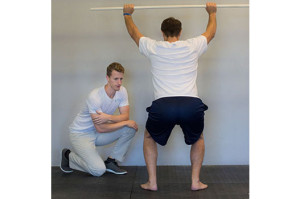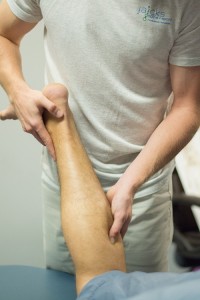What is Functional Chiropractic?

Dr. Jaicks Treats 5k/10K Runners
October 6, 2015When I introduce myself as a functional chiropractor, I often get a follow up question along the lines of “what is a functional chiropractor?” or “how is that different from a regular chiropractor?” This post will give you a good idea of the functional chiropractic approach and the concepts used in the evaluation and treatment of patients.
Simply put, “functional” chiropractors focus on how the body moves and functions a whole instead of focusing on just the area of complaint. Our brains and nerves control how the muscles operate, which in turn moves our joints. Any dysfunction or problem in this system leads to stress points, compensations, and feedback to your brain in the form of pain. As a functional chiropractor I evaluate the joints and muscles individually, how they  work during movement, and how they may be compensating for immobility, weakness or injury. The walking, sitting, bending, and lifting we all do constantly throughout the day will often irritate joints, muscles, and other soft tissues if done improperly.
work during movement, and how they may be compensating for immobility, weakness or injury. The walking, sitting, bending, and lifting we all do constantly throughout the day will often irritate joints, muscles, and other soft tissues if done improperly.
For the most effective and sustainable results, these movement pattern need to be addressed. Otherwise, the likelihood of the pain and irritation returning is high. I use movement tests that relate to these everyday activities and to your specific condition to assess your joint motion, muscle function, and motor control. Then a combination of adjustments, soft tissue techniques, muscle activations, and exercises and used to correct the dysfunctional pattern and reduce pain.
Advances in research, diagnostic imaging, and the understanding of biomechanical relationships have led to a paradigm shift in chiropractic approaches from the traditional model to more of a dynamic, or functionally based model. And the connection between the muscle-joint relationship and pain production mechanism is becoming clearer every day. As improper joint and/or muscle function is hard to avoid, we continue to see a high majority of the population suffering from musculoskeletal pain to some degree. This is where functional chiropractic and the specialized understanding of how the body compensates becomes important. Many chiropractors will undergo additional training in functional testing and muscle release to acquire the knowledge and skills necessary  to diagnose and treat these conditions. My training in ART and Graston-like techniques to address muscular restrictions and dysfunctions, Neurokinetic Therapy for global and regional muscle pattern assessment and McKenzie Method to better educate patients and self-treat their own conditions. These additional strategies incorporate some of best of chiropractic and physical therapy to provide comprehensive, evidence-based treatments.
to diagnose and treat these conditions. My training in ART and Graston-like techniques to address muscular restrictions and dysfunctions, Neurokinetic Therapy for global and regional muscle pattern assessment and McKenzie Method to better educate patients and self-treat their own conditions. These additional strategies incorporate some of best of chiropractic and physical therapy to provide comprehensive, evidence-based treatments.
With these skills, a doctor of chiropractic can non-invasively address the entire musculoskeletal system, not just the spine. Conditions like plantar fasciitis, frozen shoulder, carpal tunnel, and knee and elbow pain can be treated safely and effectively using the functional approach. If you would like more information about the services provided at Jaicks Spine and Sport, please feel free to get in contact by phone or email. I offer free no-obligation consultations to answer any questions or concerns you may have.
![Jaicks_logo_final[1]RGB208](https://jaicksspinesport.com/wp-content/uploads/2015/08/Jaicks_logo_final1RGB208.png)
